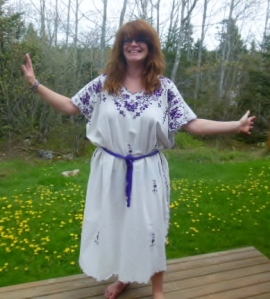I recently took part in a linen challenge, which was to take any linen, or combination there of, and turn it into something new. Well I tried really hard and was not in the least happy with how it turned out. But I didn’t give up, and managed to save it. I have to tell you it is comfortable and I enjoyed wearing it, but I have not been looking forward to blogging about it. Who enjoys telling about their failures?? Plus the weather is starting to stay nice here, which makes it even harder to sit down and type….at least that is the story I am sticking too…..
I started with an oval cotton table-cloth with a wide lace trim, a sheer curtain panel with an outline of a flower and a purple crochet doily. The basis of what I wanted to do with it was sound….the outcome less so. *big sign* well, here goes nothing….
At the oval ends I cut out two wrap skirts, making one a whole lace width smaller. I then cut out two layers of the curtain using the smaller piece as the guide. Lastly I removed the lace off the rest of the tablecloth.
First up was dying the tablecloth/skirt. I picked two shades of purple. I used a technique that I have used before and like the look of. It uses ordinary acrylic paint, and gives a slightly variegated look. I dilute the paint with lots of water, place the fabric in the wash and lift and push and stir and poke until the entire piece of fabric is covered. Just let it sit for a while, usually around 30 minutes, and than rinse with cold water until running clear. Let dry and iron. I have used then method on smaller pieces and have found it works fine, if you like the slightly variegated/tie-dyed look. You need to make sure you use enough water or it will be stiff.
Which brings me to mistake number one….painting one of the lace layers. I used a silver acrylic paint, but did not dilute it enough….it was standing on its own when it dried! I soak it in water, scrubbed it, soak it some more, add rubbing alcohol to the water and scrubbed scrubbed it more. Finally I removed enough paint that is was flowy again.
I then sewed to lines down the center of the lace doily and cut it apart. I used the leftover tablecloth to make the waist band.
I took the left over laced, which I also dyed and sewed it to the curved bottom of the curtain fabric. I then laid all the layers down and basted them together. Here was my second mistake…not trying the skirt of for looks…would have saved a lot of disappointment.
The two pieces of the waistband were sewed together with the lace doily between them. This was opened up and iron down , with the doily to the front, and the top edge edge-stitched. The front waistband was sewed to the skirt, being careful not to catch the doily. I then sewed the inside waistband down, following the seam-line of the front band, sewing the doily down at the same time.
OMG!!! Fits the hips and huge on the waist, so I threaded elastic through the waistband. Much better. Then added the closures and tried it on again. Not bad, but so so SO not me….plus it made me feel like all you would see was hips!
I put it aside for a few days and thought about what I could do with it. It took a few days before burning it wasn’t the first answer. I removed the waistband/doily. I played around with the idea of removing a single layer of curtain, but decided to remove both. I took the lace off the curtains and sewed it to the top layer of the skirt, just above that layer of lace.
Next was the shaping. Darts in the back helped, but it needed more, so I did a series of tucks in the front, as well as on each lace strip so that it would fit into the new waistband better.
There was enough tablecloth left to do the waistband and ties. I had since dyed it with a white dress, but the color works well with the skirt. After attaching the waistband and ties, and put in a buttonhole for the tie.
Now it fits much better, and is so much less bulky than before. I really like it now.
I hope my errors will help someone know where to go right when they try this. Every error is a chance to learn, or try, something new.





























